
What makes an exciting roller coaster?
It is thought that the origins of roller coasters date back to the 17th century, when ice slides were built in Russia. Woodenframed structures up to 20 m tall would be sprayed with water and left to freeze so that thrillseekers could toboggan down them. To this day, there are roller coasters across Europe known as Montagnes Russes, Russian Mountains.
Opinion differs as to whether the French or Russians introduced wheeled carts to the slopes. Catherine the Great is reported to have demanded a design to be erected in 1784 using wheeled carts instead of sledges on ice. Others claim that Belleville and Paris were the first – in 1817 – to introduce cars to rides.
The introduction of new technology such as virtual reality is set to increase the riders’ sensory experiences
What is accepted is that the first golden age of the roller coaster was during the 1920s, when there were more than 3,000 of them in operation. For a variety of reasons, including war and financial depression, the rides were so out of favour by the late 1970s that they faced extinction, with only 300 surviving.
Now, the number is up to nearly 4,000 and rides are being built at a rapid rate around the world. The use of magnetic and hydraulic propulsion systems has generated even faster rides with greater acceleration. The introduction of new technology such as virtual reality is set to increase the riders’ sensory experiences.
Prioritising safety
🦺 How is the safety of roller coaster rides ensured?
Roller coaster rides are meant to be thrilling but not dangerous. International safety standards form part of the approach to help the roller coaster designers and manufacturers meet the safety requirements and engineering quality and design safety reviews of rides by the client, third party, national bodies and high level, experienced engineers. Analysis and computer simulations make use of finite element analysis (FEA) models, dynamic analysis and risk and hazard calculations. Each project uses a product lifecycle management (PLM) approach and design-for-maintenance to optimise the maintainability and the durability of the roller coaster over its expected lifetime. Component testing is carried out to validate equipment, ensure structural integrity and establish wear for endurance. Tests include factory-acceptance tests, ride assembly try outs, ergonomic and restraint tests.
Design considerations
Most roller coaster ‘trains’ are not powered and rely on a chain or launch mechanism to take them to the first, and usually tallest hill. Gravity then carries them around the twists and turns of a track, back to the start again. Potential energy is gained as a train is pulled to the top of a hill, and when the train rushes down a slope this is converted into kinetic energy. Kinetic energy is greatest at the lowest point of the roller coaster, where the train is at its fastest, and determines how high a train will be able to climb to gather potential energy on future inclines. It also ultimately dictates how long the ride will last.
It is this interplay between potential and kinetic energy that keeps a train moving over bumps and through loops, despite loss of energy through friction and wind resistance, so that brakes are needed to bring it to a complete stop at the station. These basic laws of physics are used not only to design a track, but to create a safe but thrilling experience for a rider.
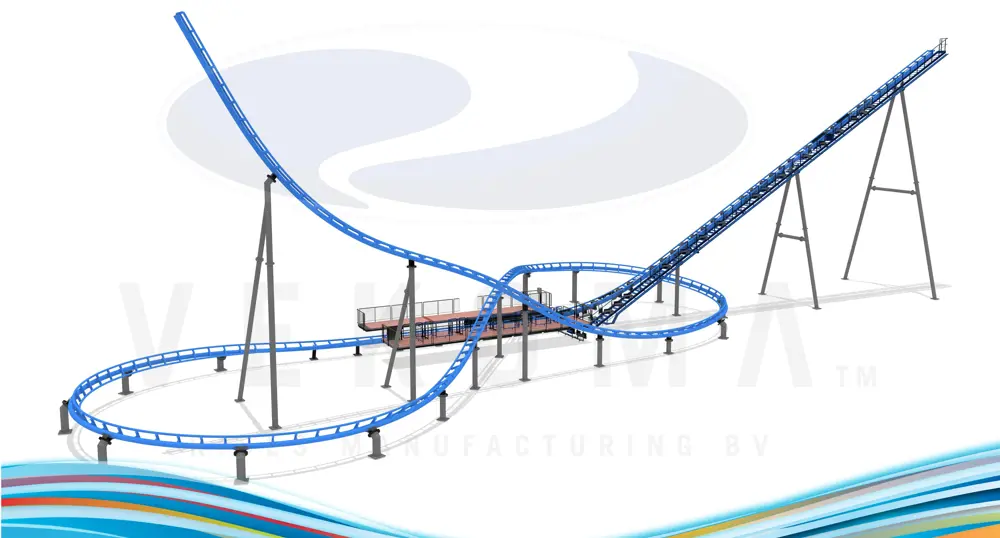
Original design for the Family Boomerang-Rebound being built by Vekoma at Paultons Park, Hampshire. The ride has a tyre-drive system that carries riders backwards up the right hand hill before the tyres disengage on the underside of the train allowing it to freewheel forwards, gathering momentum to travel round the track. The train has enough potential energy to climb the left hand spike before returning riders back to the station in the centre of the attraction © Vekoma Rides Manufacturing
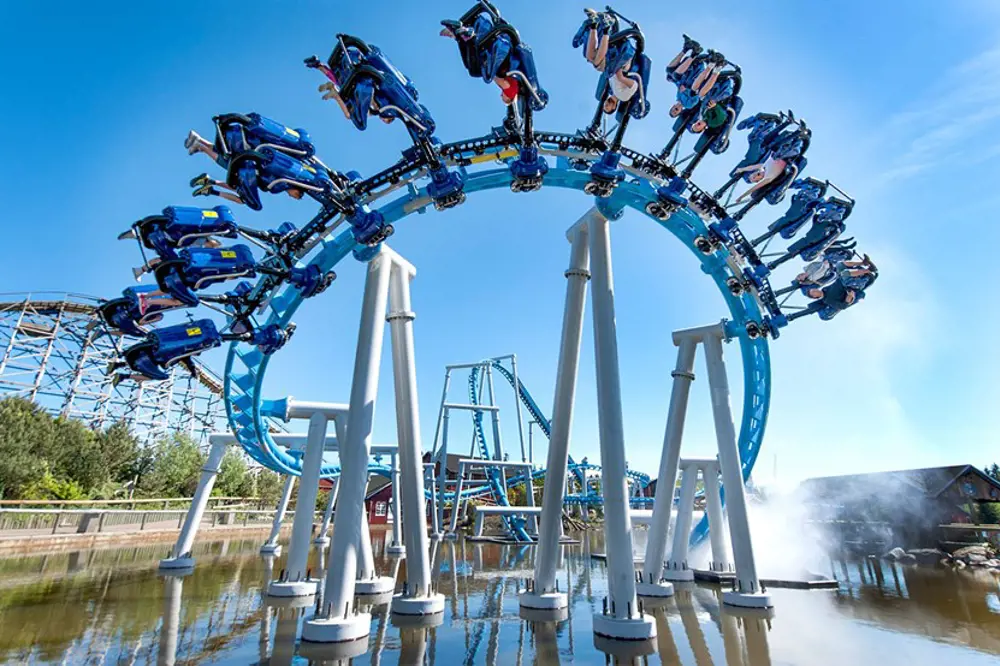
Vekoma has created nearly 300 roller coasters worldwide. The Orkanen at Farup Sommerland in Denmark, was installed in 2013 and has features including a speed bump, a carousel, steep drop, a 120° banked horseshoe followed by horizontal loops and s-curves © Vekoma Rides Manufacturing
Unpleasant bumpy and jerky tracks were a problem for older roller coasters, and users could end up with bruises on hips, knees, shoulders or ribs. The current design approach, however, means a smooth ride is at the heart of a design. Using computer models, engineers have direct control over the flow of forces and can create a virtual ride that can be analysed before it is built.
Fraser Ross, Concept Engineer for Vekoma Rides Manufacturing, uses this modelling when creating new roller coasters. A new ride developed by Vekoma called Orkanen, at Farup Sommerland in Denmark, is an example using the updated design method. It boasts organic, naturally flowing shapes, limited lateral swinging dampened by shock absorbers, padded ergonomic seats for comfort and a restraint system designed for children as small as 1.1 m tall. The ‘suspended family coaster’ has been well received since it opened in 2013, and five more have been ordered for theme parks worldwide.
Using computer models, engineers have direct control over the flow of forces and can create a virtual ride that can be analysed before it is built
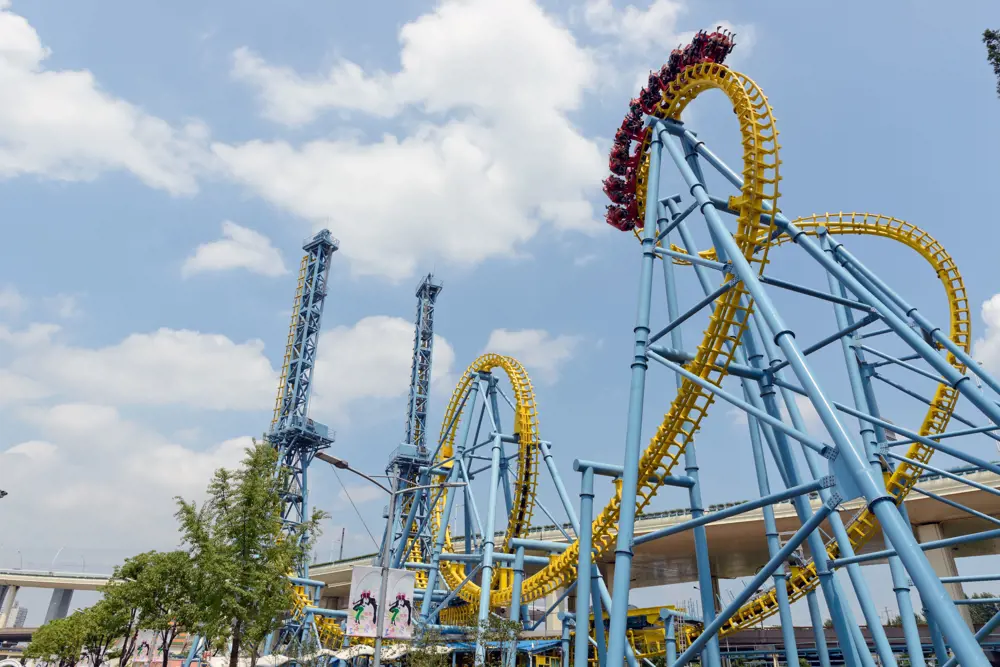
A cobra roll involves 2 half loops with a twist in the middle. This shows the Vekoma Giant Inverted Boomerang at Shanghai Jin Jiang Park. The passengers are upside down at the crest of the cobra they are experiencing positive Gs and are held in their seats by centrifugal force © Vekoma Rides Manufacturing
Feel the force
Positive G-forces are experienced by passengers when moving upwards at speed, while accelerating, when pulling back up at the bottom of a drop or going through a tight corner. They are negative when decelerating, cresting over the top of a hill and when dropping back down. Concept engineers take into account the vertical, lateral and longitudinal accelerations on the passengers and the train. Human tolerances depend on the magnitude of the G-force, the length of time it is applied and the direction in which it acts. People would experience a higher G-force falling into bed than on a roller coaster; however, the duration of that G-force to the bed is so short it is almost imperceptible.
People would experience a higher G-force falling into bed than on a roller coaster; however, the duration of that G-force to the bed is so short it is almost imperceptible
The limit for positive, or vertical, G-forces for a thrilling but comfortable experience where the blood is forced away from the head so the body feels heavy, is around 6Gs, the same experienced by fighter pilots. Entering into the bottom of a loop, riders would usually experience around 4Gs of vertical force, which effectively means five times their bodyweight is being pushed into their seat. This feeling only lasts for a split second, so is thrilling but not too intense.
For an ‘airtime moment’, when there is a fluttering, breathless feeling in the pit of the stomach, engineers can incorporate a ‘camelback’, or hump-shaped hill that travels in a straight line, with 0Gs (or less) of vertical acceleration, which will make riders lift out of their seats and add a sense of thrill to a ride.
When a train accelerates or decelerates, longitudinal forces act forwards and backwards, pushing passengers back into their seats or forwards into their restraints, making a launch seem even faster, or braking more urgent. Both positive and negative lateral G-force accelerations are experienced as a train races round curves, with the tightness of a curve determining the magnitude of the lateral force being experienced by a passenger.
Thrills not spills
G-force is only one of the ingredients needed to create a thrilling ride. Brendan Walker, Professor of Creative Industries at Middlesex University and Principal Research Fellow in Computer Science at the University of Nottingham, has been dubbed the ‘world’s only Thrill Engineer’ by The Times. He works with theme parks on rides and says that an exciting ride relies on a combination of physical and psychological elements. Rides are designed to excite the senses, and this should begin with the appearance of a roller coaster. It should look impressive, exciting and even a little intimidating to someone waiting to ride it, to set their expectations for a thrilling ride.
Rides are designed to excite the senses, and this should begin with the appearance of a roller coaster
Roller coasters should also make people feel as if they can do the impossible, such as fly unaided or survive a high drop. Features such as loops and plunges are incorporated, which act on the vestibular system in the inner ear. This system senses acceleration and a yanking feeling, known as ‘jerk’, to create thrilling sensations.
Professor Walker explains that roller coasters should make riders feel as if they have lost control, which triggers the body and mind’s state of alertness, or arousal. This can be caused by unusual forces such as jerk, or varied jerks known as ‘jounce’. The feeling of being out of control can be triggered by rapid acceleration as well as sudden drops and loops, but variety and the element of surprise are needed to sustain a state of arousal.
Combinations of features might include a negative G-force experience known as a ‘hop’ to produce a lurching feeling in the stomach, followed by a pull out of a drop to create positive G-force, with designers manipulating a rider’s expectations and building suspense. The clothoid loop is a defining feature in many modern roller coaster designs – see Inverted teardrop.
Inverted teardrop
💧 How the inverted teardrop shape ensures riders can comfortably be inverted on a rollercoaster
Early roller coasters included circular loops to invert riders, but a constant radius required a high velocity to complete the loop, subjecting riders to a high centripetal acceleration at the bottom of the loop as well as a more intense vertical G-force, resulting in discomfort.
To solve this potentially dangerous problem, engineers came up with the clothoid loop, which is an inverted teardrop shape that is effectively a section of a spiral in which the radius is constantly changing.
The radius of curvature is much larger at the entrance and exit of its loop element than in a circular loop, allowing for a much more comfortable transition as well as less intense vertical G-forces.
Smaller radii at the top of the loop also mean trains can travel with a lower velocity at the top, while still completing the loop, giving a larger centripetal acceleration with a lower speed and a more comfortable, but thrilling experience for passengers.

Generating momentum
In order for riders to feel the force of a clothoid loop or corkscrews, the train they are sitting in has to have enough kinetic energy to reach a high enough speed to carry them, upside down, safely through the loop. While the great majority of roller coasters use traditional lift hill chains to pull a train up the initial highest hill, now rides are being built that are capable of launching trains at much higher speeds.
Electromagnetic launch systems, introduced at the end of the 1990s, require no moving parts and so require less maintenance than hydraulic launch systems or traditional lift hill chains. They use electrical impulses to attract or repel ‘fins’ on the underside of roller coaster trains. Vekoma uses two types: linear induction motors (LIM) and linear synchronous motors (LSM).
The main difference between the two is where the magnets are positioned. LIMs use sets of electromagnets mounted on a track, to which alternating current is applied to create a magnetic field. A train is propelled rapidly forward when its metal fin passes through the magnetic field generated.
In contrast, strong magnets are secured to a train on a track in an LSM system and rely on the basic principles of attraction and repulsion (using a DC motor). When a train approaches magnets on the track, it is attracted to them, and when it passes over them the magnetic field is reversed to propel the train away from the magnet, forward down a track. When sets of track magnets are fired rapidly, they can propel a train at great speeds.
Hydraulic launches have the advantage of consistent power requirements and are used on some of the world’s fastest coasters, including the Formula Rossa at Ferrari World in Abu Dhabi
Alternatively, hydraulic launch systems, which have similar function principles to a ‘catapult’ mechanism on an aircraft carrier (although powered by steam), are used for the world’s three fastest roller coasters – see Hydraulic motors.
Hydraulic launches have the advantage of consistent power requirements and are used on some of the world’s fastest coasters, including the Formula Rossa at Ferrari World in Abu Dhabi. This ride uses 48 hydraulic motors to fire riders to 240 km/h in five seconds.
Hydraulic motors
🎢 How does a hydraulic motor work to launch a roller coaster?
With a hydraulic launch, a ‘catch car’ runs underneath the coaster’s train and track on the end of steel cable locks. At the other end, a large winch drum is attached to a series of hydraulic motors. Hydraulic fluid is forced into a number of accumulator chambers, compressing nitrogen gas. When the ride is ready to launch, valves are released allowing the nitrogen gas to push the fluid back through the motors, causing the winch to spin up and pull the cable along. Nitrogen is used as it is highly compressible and returns to its original volume quickly. After the launch, the catch car travels back down to the launch area, ready to attach itself to the next train. While this happens, the fluid is pushed into the accumulators, in effect recycling the whole launch process.
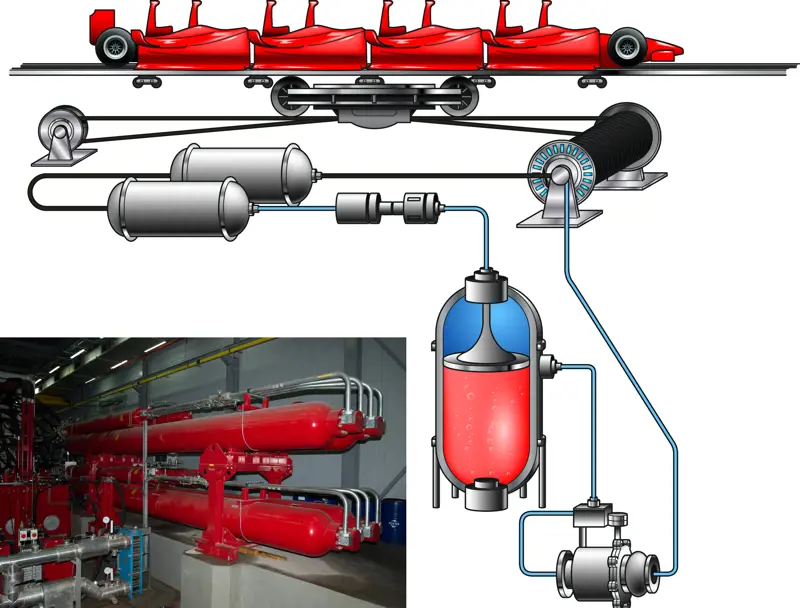
© www.howitworksdaily.com (diagram), Justin Garvanovic European Coaster Club (photo)
New experiences
Professor Walker believes one of the biggest barriers to creating bigger, faster and more imaginative rides is risk aversion. As roller coasters cost in the region of £10million to £20million to build, the parks need to ensure a wide enough demographic of customers to make the investment worthwhile, which can limit innovation.
The next generation of roller coasters could look radically different from the geometrically shaped ones with specially shaped loops and vertical drops we know today

Situated in Europa-Park’s Iceland-themed area, the Blue Fire ride (created by Mack Rides) in South-West Germany has five trains with seats for 20 people in each. The lap bars that hold the passengers in place contain embedded pulse monitors. Riders can purchase a DVD that shows their faces and their pulse rates during the ride © Europa-Park
However, new ride design software is allowing engineers to create more organic roller coaster elements which have not been seen before. Rides using organic shapes are designed to create more fluid, graceful, less artificial rides to give the effect of flying or diving into water. The next generation of roller coasters could look radically different from the geometrically shaped ones with specially shaped loops and vertical drops we know today.
New track shapes will be created such as a cross between a clothoid loop and a corkscrew. This will allow the rider to experience the sensation created by a clothoid loop and corkscrew simultaneously. By mixing the two, a ride will not only look new and exciting, but will provide new stomachchurning sensations for riders too.
Marcus Gaines from the European Coaster Club has seen other innovative trends being implemented. More manufacturers are coming up with lap bar designs that give riders greater freedom of movement. Lap bars used to be popular, and were used on rides with only positive G-forces, such as Scorpion at Busch Gardens, Florida, but now they are being used utilised by some companies on coasters with negative G-forces and inversions other than a standard vertical loop.
The shape of the seat also plays a role in securing the rider in place. The design can make rides seem scarier, particularly if customers are flung upside down, enhancing the adrenalin buzz of a ride.
There is also a move away from steel tracks back to wooden ones, to capture a bygone age of roller coasters, and to save money as they’re typically cheaper to build than big steel coasters. While they are not currently popular in the UK, elsewhere firms are pushing their limits, building faster, steeper wooden roller coasters with loops. In the US, Rocky Mountain Construction unveiled its first wooden roller coaster to go upside down in Silver Dollar City, Missouri, in 2013, and will unveil the world’s first launched wooden roller coaster at Dollywood, in Tennessee, this spring. Last year, Martin & Vleminckx Rides built two wooden coasters in China that featured corkscrew inversions.
A trend that is starting to make its way into theme parks is the incorporation of virtual reality into roller coasters
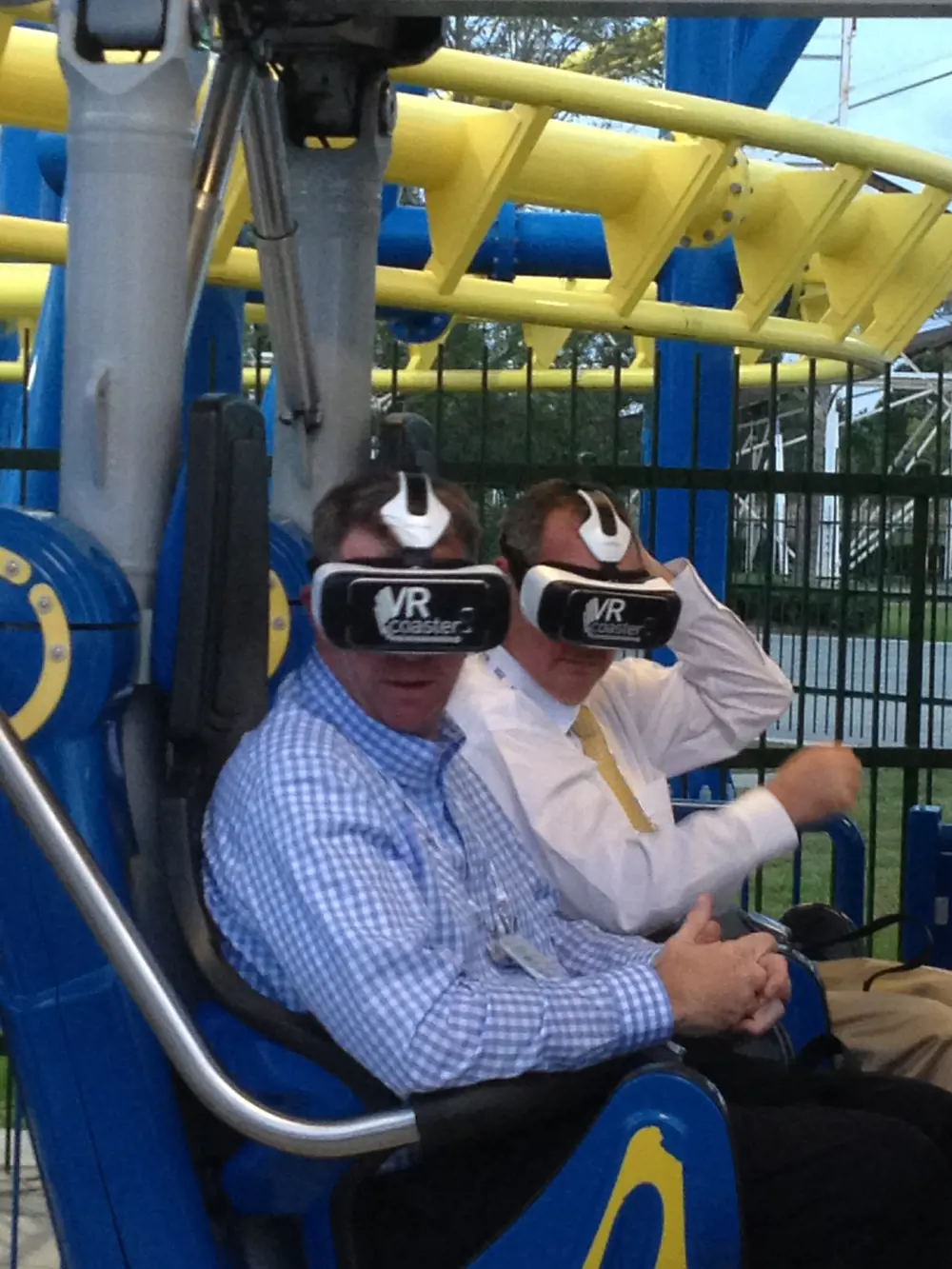
Vekoma’s Suspended Family Coaster AlpenexpressFreedom Flyer at FunSpot Orlando, Florida was recently used to demonstrate the virtual reality Coaster system developed by a partnership between Mack Rides and University of Applied Sciences Kaiserslautern. Here it is being tried out on Vekoma’s Suspended Family Coaster Freedom Flyer VR coaster at FunSpot Orlando, Florida
A trend that is starting to make its way into theme parks is the incorporation of virtual reality into roller coasters. For the past couple of years, Mack Rides in Germany, in partnership with a local university, has been working on combining VR with roller coasters. In 2015, the public got the chance to try out the world’s first VR Coaster at Europa Park, in Rust, Germany.
Alton Towers has been working with the Guildfordbased firm, Figment Productions Ltd, to revamp its Air roller coaster to create a VR roller coaster experience. From April 2016, the ride will have an outof- this-world theme and is to be called Galactica with riders wearing headsets based on the Samsung Gear VR system.
Figment has developed Vector VR, a patent pending system that includes a custom sensor, fixed next to a rider’s seat, with an inertial measurement unit that constantly monitors the movement at that point on the train and compares it to a ‘master path’ captured by the same sensor.
The visuals that show up on a rider’s headset controlled by the Vector software algorithms sync with the sensor so they match the motion of the roller coaster train and position the rider in the right space in the virtual world. The headset also adds tracking for rotational head movements, completing the picture to match what the rider sees with what their vestibular system tells their brain they should be seeing. This is key to minimising motion sickness and the system means that a 90° sweep can easily be manipulated to become a 360° turn. Galactica riders will also be in a prone position intended to increase the sensation of flying, allowing riders to stretch their hands out and feel the wind in their face.
Short history of the coaster
⚙️From the first ride with no brakes to being flipped upside down
What is considered to be the first true roller coaster opened at Coney Island in New York in 1884. LaMarcus A Thomson built the wooden Gravity Switchback Railway. Back then there were no brakes on the track; instead a brakeman would ride on the train, manually operating brakes on the wheels.
In 1912, engineer John Miller made a huge safety improvement that remains an integral part of today’s modern roller coasters, upstop wheels. These are an extra set of train wheels that run on the underside of the track, designed to prevent a train from flying off, crucial for moments of negative G-force or for looping upside down.
The first steel roller coaster appeared in Germany in 1906. Showman Karl Gabriel introduced the world to the 10 m tall Devil’s Wheels at the Munich Oktoberfest. Gabriel created the steel roller coaster so that it was portable and could be easily dismantled, relocated and rebuilt.
The Matterhorn Bobsleds at Disneyland in California, built by Arrow Developments, was the first steel coaster using tubular track which enabled sharper turns. It was this 1959 roller coaster that created the surge of interest in steel coasters, and the downturn in wooden coasters.
It wasn’t until 1975 with the Corkscrew at Knott’s Berry Farm, California, that thrill seekers would be flipped upside down. The popularity of steel roller coasters became apparent in 1986 when, for the first time, steel coasters outnumbered wooden ones.
During the 1990s and early 2000s there was more than a decade of competitive building, with theme parks battling to have the tallest or longest steel coasters. The UK played its part with Lightwater Valley opening The Ultimate, which at 2,268 m became the longest coaster in the world, holding the record for nine years until the Steel Dragon 2000 opened in Nagashima Spa Land in Japan. Blackpool’s Pleasure Beach claimed the ‘world’s tallest’ record in 1994 with the Pepsi Max Big One measuring 65 m tall; today that record is held by the 139 m high Kingda Ka at Six Flags Great Adventure, New Jersey.
Compiled by Marcus Gaines, European Coaster Club.

The Coney Island Switchback Railway had a car that coasted down 180 m of track. The charge was 5c and the maximum speed around 9 km/hr Image courtesy Brownstone Detectives (left). The original Corkscrew ride at Knott’s Berry Farm © Californiacoasterkings.com (right)
On the up
Just as roller coasters seem to push and pull their riders in different directions, the future of the rides themselves is diverging. Use of organic-shaped rides and virtual reality technology will lead to more immersive and smoother experiences for riders, while noisy, back-to-basics wooden tracks will play on more primal fears to arouse the senses.
What is certain is that there will be faster, more testing experiences on offer than ever before. There are now nearly more than 4,000 coasters to ride, in what is being hailed as the dawn of the second golden age of roller coasters.
***
This article has been adapted from "What makes an exciting roller coaster", which originally appeared in the print edition of Ingenia 66 (March 2016).
Contributors
Sarah Griffiths
Author
Fraser Ross was a Concept Engineer at Vekoma Rides Manufacturing BV between 2012 and 2018. Fraser’s work, hobby and life was centred around roller coasters and theme parks. He specialised in designing roller coaster track layout and related analytical assessment of vehicle dynamics. He is currently a React Naitive Engineer at Ooni.
Professor Brendan Walker is a technology-inspired artist, engineer, and broadcaster who specialises in the creation of tailored emotional experience. He originally trained as a military aeronautical engineer at Imperial College, before studying design at the Royal College of Art. He is the Founding Director of Studio Go Go Limited.
Keep up-to-date with Ingenia for free
SubscribeRelated content
Mechanical

When will cars drive themselves?
There are many claims made about the progress of autonomous vehicles and their imminent arrival on UK roads. What progress has been made and how have measures that have already been implemented increased automation?

R&D investment makes good business sense
In just five years, Dr Ralf Speth FREng has presided over a revolution in design and manufacturing that has helped create a new family of engines and has overhauled Jaguar Land Rover (JLR) production facilities.

Bikes help improve skills and attitude
The Archway Project is an independently-funded scheme that is expanding its engineering-based programmes by providing BTEC certificates and diplomas. John Milton, the director of the project, explains what the charity does to help reduce anti-social behaviour and improve employment prospects.

High speed evolution
In December 2010, Eurostar International Ltd awarded a contract for 10 new high speed trains to Siemens. The company has used a system developed over decades to maximise the performance and passenger-carrying ability of its 320km/h trains.
Other content from Ingenia
Quick read

- Environment & sustainability
- Opinion
A young engineer’s perspective on the good, the bad and the ugly of COP27

- Environment & sustainability
- Issue 95
How do we pay for net zero technologies?
Quick read

- Transport
- Mechanical
- How I got here
Electrifying trains and STEMAZING outreach

- Civil & structural
- Environment & sustainability
- Issue 95